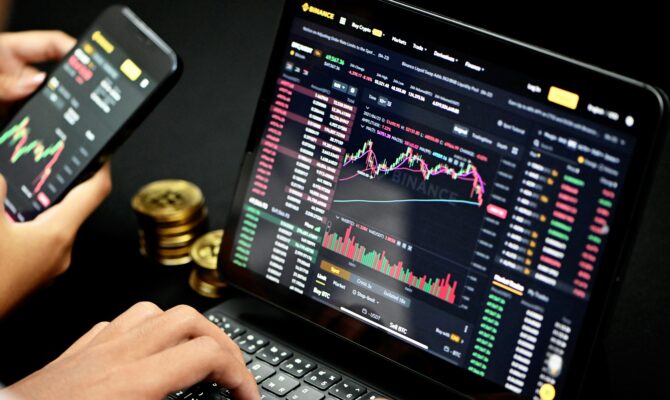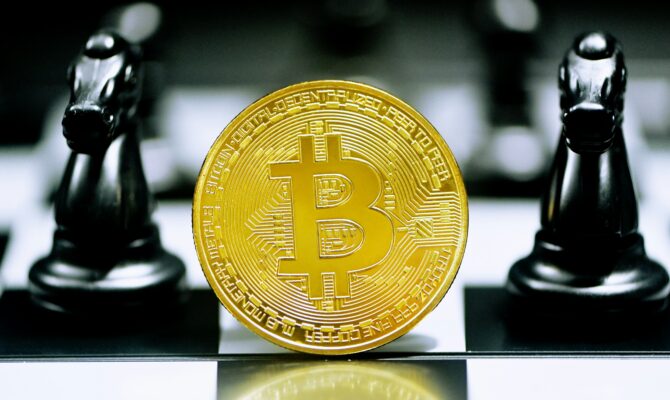

Bitcoin’s prominence has risen in the public eye and become a popular investment with key wealth creators. But despite cryptocurrency being one of the most accessible investment opportunities, open to everyone, many remain intimidated by the digital landscape. Indeed, people feel safest in familiar territory. Thus, the best way to feel secure in cryptocurrency is to demystify it by gathering knowledge.
The safest approach to investing in Bitcoin is by educating yourself through your own research and not following micro-trends. It is essential to have an investment strategy, including familiarizing yourself with the currencies, exchanges, and basic security measures.
Headline News is full of scary Bitcoin stories, making the crypto market sound like a murky world full of criminals ready to scam you at any moment. Just remember this: people fear what they don’t understand, which has been the case since the car replaced horses and carriages. So, just as we know not to give out our bank card PINs, there is essential safety advice for owning Bitcoin. People learn this advice by familiarizing themselves with the crypto market. It’s all about empowering yourself through knowledge.
Educating yourself through research and participating in our course is the safest way to begin building your crypto portfolio and learning to be your own bank. But we are always here to help by providing information on our blog, Facebook page, or contact us.
As always, we stand by our three cardinal rules for investing in Bitcoin and other cryptocurrencies:
To the last point, we are not saying Bitcoin is a bad investment and that you will ‘lose.’ Quite the opposite, Bitcoin is on the path to becoming one of the most scarcest assets on the planet. But the safest way to invest is by playing the long game with a “buy and hold” approach commonly known in the crypto-world as “HODL.”
To ensure you can fully optimize the HODL strategy, the money you invest can’t come out of your mortgage. Instead, it needs to be money you can build on to become your own bank and achieve financial freedom.
But to help jump-start you on your research, let’s back up and go over the basics of investing in Bitcoin and other cryptocurrencies.
Bitcoin is the first and original cryptocurrency, therefore, the oldest. The coin was created by Satoshi Nakamoto, whose true identity is unknown to the public. Coins that are minted cannot be replicated due to underlying blockchain technology. Nor can they be “hacked” as their code on the blockchain isn’t stored on a single source. The technology also limits the number of total Bitcoins minted to 21 million.
These are crucial differences between cryptocurrency and fiat money. Bitcoins are decentralized rather than controlled by a central government that can print more on a whim, devaluing the currency and creating inflation. Instead, while Bitcoin’s daily value moves around, it is becoming a scarcer and scarcer asset with an overall increasing worth.
Thus, those who buy Bitcoin and cryptocurrencies to make a quick get-rich buck can get burned. But those that follow a strategy based on more significant, overall patterns can find success due to respecting the currency’s framework. There are various long-term financial strategies, but one is Dollar-Cost Averaging, which you can read more about here.
Bitcoin is far from the only cryptocurrency. As of March 2022, there were over 18,000 cryptocurrencies available. However, the leading players in the crypto market are far smaller, with only a handful of big names.
The more well-known currencies, the so-called ‘Blue Chips’, are often (but not always) viewed as a safer investment than the unknowns. But all currencies come with advantages and disadvantages. What works best for the investor typically depends on their crypto portfolio strategy.
Ether is the second-largest currency in the digital landscape. It is a cryptographic token used on the Ethereum (ETH) blockchain. ETH aims to be a decentralized and fully accessible financial marketplace where financial products are protected through “smart contracts.”
Ethereum’s algorithm no longer runs on PoW (proof of work), a key mechanism of Bitcoin. Instead, they use PoS (proof-of-stake). Pushing aside lengthy technical explanations, the result is that PoS uses less energy and, consequently, allows a faster transaction speed.
Dogecoin rocketed to fame in 2021 after Elon Musk named dropped it on Saturday Night Live. The currency originated in 2013 thanks to Billy Markus and Jackson Palmer. The men started it as a joke, even choosing a dog breed, Shiba Inu, to create the face of its coin.
Despite its amusing origins and avatar, Dogecoin has a dedicated and loyal fan base, including some major companies. The currency is open-source, peer-to-peer, and “inexpensive” compared to cash such as Bitcoin. Nor is there a cap on the potential number of Dogecoins that can be made. Thus, it operates with a different mindset from the Bitcoin framework. In some regards, it’s an ‘anti-Bitcoin’ token.
Ethereum co-founder Gavin Wood created polkadot. Wood disagreed with the direction Ethereum was headed and thus, created a blockchain that spoke to his vision. Polkadot has a unique technology that allows users to customize blockchains known as parachains. Polkadot’s currency is DOT, and big names, including Deutsche Telekom AG, have purchased its tokens.
Tether is a unique example, as it is a stablecoin, meaning it is “tethered” to a fiat currency. This makes their value more “stable.” However, this takes away from one of the original tenets of digital currency as it is no longer decentralized. By being tethered to a fiat currency, it is then influenced by governments that control the fiat currency. Nonetheless, the concept has its fans, making Tether popular.
Bitcoins and other cryptocurrencies are purchased and sold via crypto exchanges. Just as there are numerous cryptocurrencies, there are many crypto exchanges. Crypto exchanges have their pros and cons. For example, some exchanges hold your currencies on their platform, which is not something DWG recommends. We are firm proponents of the motto, “Not your keys, not your coins.”
Fees are another big difference between exchanges. As demonstrated in our previous article on crypto exchanges, fees can significantly impact your buying and investing power.
Ease of use is another factor when selecting a crypto exchange. If new to the crypto market, some exchanges might have a broad offering, but the complexity can be overwhelming. As we stated from the start, knowledge is instrumental to safely investing in Bitcoin. If an exchange is confusing, this raises the chances of making costly mistakes or leaving yourself vulnerable.
It is also crucial to research if an exchange offers its complete services to Australian residents. Exchanges don’t necessarily deal with all fiat currencies, either. This doesn’t mean Australian residents should always use an Australian-based exchange. An Australian exchange may not deal with your preferred cryptocurrency or might not have the services you require. It all depends on your particular long-term investment plan.
Investors are not limited to using one crypto exchange. In fact, at DWG, we find it advantageous to use more than one exchange. For example, Australian exchanges are excellent for getting our dollars in and out of cryptocurrencies. However, when making exchanges between cryptocurrencies, there are times an international exchange is a bitter fit.
Thus, educating yourself on a variety of crypto exchanges is advantageous. It will help you ensure your money is working hardest for you. Below are a few examples of crypto exchanges, both local and international.
FTX launched in May 2019 and is one of the largest exchanges in the world. It is owned and operated by billionaire Sam-Bankman-Fired and his co-founder Gary Wang. It supports over 150 cryptocurrencies, trades over $ 10 billion per day, and has over a million registered users. It is a popular platform and is known for being user-friendly and for its low fees. Australians can use FTX as long as they complete several application forms.
BTC Markets is an Australian exchange based in Melbourne. It launched in 2013 and has a high trading volume, which is preferred over low-volume exchanges. They also have a high maximum trading limit, which is another desired quality.
CoinSpot is another Australian exchange that also launched in 2013. They are certified with Sci Qual and Blockchain Australia. They are a user-friendly platform, complete with Live Chat support, which helps first-time investors feel more secure. They also offer many cryptocurrencies, from big names to smaller altcoins.
Kraken is a United States-based crypto exchange that launched in 2011. It is unique because it holds a Special Purpose Depository Institution license (SPDI), thus ranked as a highly secure crypto exchange. They are focused on trading and staking, supporting over 100 cryptocurrencies. They announced their launch in Australia in 2020, setting up operations in Sydney.
One of DWG’s biggest safety tips is understanding crypto wallets. Wallets hold the keys to your digital wealth. As mentioned above, we believe in the motto “Not your keys, not your coins,” thus we prefer hardware wallets to software wallets.
To recap, hardware wallets hold your keys offline on a device that looks similar to a flash drive. Whereas software wallets keep your keys online, leaving them vulnerable to hackers. You can read more about why we believe it is safer to keep the keys to your coins offline in our post: Looking After Your Private Keys – Hardware Wallets vs. Software Wallets.
Software wallets are a type of online wallet. Unlike those provided by the crypto exchange (hot wallets), these are typically not directly linked with the exchange and have greater security. The risk is that a wallet kept on an exchange can be “lost” if the exchange folds where a software-based wallet is a separate entity.
Hard wallets, also called “cold wallets,” are excellent for storage when not actively using your coins and tokens. These have greater security than software wallets as everything is offline. They are not as convenient as software wallets, as the info is stored on a separate device. But for those employing a HODL strategy, this is a minor issue.
Below are a few examples of popular software and hardware wallets.
Electrum is a popular Bitcoin wallet that was released in 2011. It is easy to use, doesn’t store information on the server, and operates with two-factor authentication. However, it can only store Bitcoin.
Ledger Nano Hardware Wallets are made by Ledger, whose headquarters are in Paris. The company launched in 2014 and focused on creating blockchain security solutions, such as its hardware wallets line. Ledger devices host a wide range of digital assets. Nonetheless, check that they support your chosen coins or tokens before buying a product.
Mycelium launched in 2013, initially only for Android, but now is available to iOS too. Like Electrum, it only supports Bitcoin. For a software wallet it is considered highly secure and offers a range of features. Mycelium is also compatible with hardware wallets, allowing investors to move their currencies between options.
TREZOR launched in 2014 and is one of the most well-respected makers of hardware wallets. They support an incredible range of coins and tokens. It also has a backup system in place if your TREZOR is damaged, lost, or stolen. In addition, their devices are compatible with many software wallets, including Electrum and Mycelium.
The safest way to invest in Bitcoin is to arm yourself with knowledge. Educating yourself about the marketplace and your investment options will give you confidence in making your own decisions rather than impulsively following micro-trends or falling for scams. As mentioned at the top, we also have other security tips to help you keep your digital wealth safe and secure.
Looking After Your Private Keys – Hardware Wallets vs Software Wallets
Women Creating Savings Accounts For Their Children Or Themselves (And The Stats To Prove This)
https://digitalwealthgroup.com.au/events/how-to-build-a-crypto-portfolio-with-little-to-no-risk-make-life-changing-gains-that-you-can-retire-on-in-3-simple-steps/


The blockchain isn't known for its speed. This is by design since blockchains are geared for safety instead, making them…


Many investors experiencing their first bull market become frozen when it’s time to take profits. They watch the numbers on…


Have you started to obsess over the perfect time to take profits? Trust me, we’ve all been there! In a…
Register for the FREE 90 minute
Crypto Training